This image is a fantastic example of the use of depth of field. The lens is focused on the volleyball in the foreground using a shallow depth of field. Due to this, the trees in the background are a blur and the volleyball net fades into the distance, creating an elongating illusion. The shadow of the net in the sand also adds to the depth of this photograph. The randomness imprints in the sand shows how the area is so treaded on in disarray. There is no clear path. The repetition of the prints in the ground and the square patter in the net make people take a second look, appealing to humans' curious nature by prompting questions like: What happened here? Who did this? Why?
In this image I, of course, utilized natural light. The natural light draws the viewer's attention to the upper left corner and creates a warm, optimistic, summery feel. This photograph makes me nostalgic for warm sand and relaxing days in the sun on the beach surrounded by friends and family. Another aspect of this picture that I love is the contrast of textures. The smooth, leathery ball to the rough, grainy sand seem almost tangible.
Juxtaposition occurred here with the unexpected way the ball seems to be balanced on the bungee chord, and the bungee chord on the tip of the flagpole. This photo comments on the balance of work (the AU flag in the background, signifying education) and play (the volleyball) in my life.
This photo incorporates both focus and lack of focus. I took this focus by following a volleyball as it rose and fell through the air. The movement of the camera created a blurring effect in the sky, but I made sure the camera stayed focused on the ball, the focal point of the photograph. This photograph implies constant motion and rising and falling action.
The shadow of my hand on the volleyball tells a story is some ways. It tells the audience that someone is reaching for the ball and, presumably, will proceed to play. All this is shown without even showing a person in the photograph.





No comments:
Post a Comment